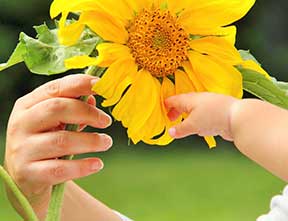
Module 5: Early Start Denver Model in Practice
Upon completing this module, you will understand the basis of the teaching practices used to implement ESDM including:
- Setting up the environment

- Play Partner Relationship
- Joint Activity Routines
Activities to support your learning:
Read Chapter 6 of the ESDM Manual.
Setting Up the Environment
There are many things in the physical environment that can be distracting and compete for a child’s attention. Computers, tablets or television, mechanical toys, and even a busy household may interfere with gaining the child’s attention on you. By identifying things in your environment that attract the child’s attention and minimizing these distractions, you will be more likely to become the focus of their attention.
Read handout: Setting up the Environment
The ideal setting:
- Is free of distractions
- Is enclosed space but with room to move
- Has activity zones
- Has materials that are accessible but contained
How to create this in a family’s home?
- Problem-solve with the family!
- Use a smaller room, e.g., child’s bedroom
- Move furniture
- Use fabric to cover distractions
- Bring containers and/or toys
- Pick up and put away toys before beginning
 The Four Key Components of the Play Partner Relationship
The Four Key Components of the Play Partner Relationship
(p. 102-108)
1. Child’s Motivation
Finding activities that are highly motivating results in a happy and attentive child who is ready to learn. Strong motivation supports active learning. The longer a child and caregiver stay engaged, the more opportunities for learning that can occur.
Read:
Understanding your Child’s Behavior
What makes your child “tick”?
Child Interest Begins the Activity
- When children are highly interested in something, they are motivated to attain the object and repeat the exchange.
- Respond quickly to the child’s interest in an object/activity while the child is in “approach mode”.
What Motivates Children With Autism?
- Contrary to stereotypes many young children with autism enjoy social activities and physical contact.
- To understand what motivates the child, observe behaviors in an environment with developmentally appropriate toys and materials.
- Introduce sensory social objects (bubbles, balloons, pompoms) and sensory social games (bouncing, pat-a-cake) to “find the smile”.
Watch: Tune In
2. Drawing the Child’s Attention
Social communication occurs though our eyes, faces, and bodies. We want our children to look at us and to have a view of our faces, expressions, gaze and mouths as we talk and interact. To do this we want to find positions that put us in the “spotlight” when interacting with your child. In other words, get down on your child’s level and be their center of attention. You can position yourself, so your baby or young child can see your face and you can see theirs. Having your child sit in a chair or beanbag can provide them with support and help them focus their attention on you. This position will give you plenty of opportunities to read your child’s body language, know where and what they are looking at, and what they are interested in. That way you can match your focus to their interests. Remember, face-to-face positioning is key to gaining your child’s attention.
Read:
Seven Ways to Build Your Child’s Focus and Attention
Nurturing early play skills
Eliminate Competition
- TV, video, computers can be powerful competition.
- Parents can also be magnets for attention or for escape. Ask parents to be completely boring or to refer the child to you to meet the need or provide the attention.
Take Center Stage
- Set up interactions so the child has a clear view of your face
 to become part of the child’s focus of attention.
to become part of the child’s focus of attention.
Watch and Comment
- Narrate and describe the child’s play actions with lively emotion to provide opportunities for new language learning.
Be Helpful
- Package toys in difficult to open containers such as zip-lock bags or clear containers with lids.
- Offer one piece of the item that the child is reaching for, steady the object, move things closer, open containers and help with struggles.
3. Taking a Role in Play
We all have different reactions to physical closeness to others. Some people need more social distance than others to be comfortable. It is important to determine your child’s social comfort zone when engaging in activities together in order to maintain his/her attention on you. The following links provide helpful information to guide you in determining your child’s individual social comfort zones.
Read: Understanding your Child’s Behavior
Imitate the Child
- Imitation builds awareness of being a “social partner” and builds interactive, reciprocal play.
- If the child wants all the materials, give them freely, take others, and start again.
Add Variations: Elaborate the Play
- Elaboration on play activities keeps it interesting and novel and extends the length of time you and the child are engaged in the activity.
- For example, add a bridge when building with blocks, or crash a car into a tower and re-build.
4. Becoming More Active
 Watch:
Watch:
Interests Lead to Learning
Control the Materials
- When a child has selected a play activity, begin with one
 piece and hold the rest. This could be puzzle pieces, balls, blocks, markers, etc.
piece and hold the rest. This could be puzzle pieces, balls, blocks, markers, etc. - Keeping possession of the pieces of the toy and handing them to the child as needed provides teaching opportunities as well as providing you control over reinforcers.
Take Turns
- Taking turns frequently in play is critical for teaching new skills.
- After the child acts on an object for a minute or two, take a brief turn by saying, “My turn,” extending your hand, taking the toy and handing it back quickly as you say “Your turn.”
Joint Activity Routines: Frames for Teaching (p.108-120)
Phases of the 4-Step Joint Activity Routines
 Step 1: The opening or set up
Step 1: The opening or set up
Child is supported to choose and become motivated to participate in the activity and helps the adult set up the theme.
Step 2: Developing theme
Builds on the theme where both adult and child participate in co-constructing of the theme.
Step 3: Add variations/elaborations
Varied use of activities and materials to expand child repertoire, target multiple objectives and build flexibility.
Step 4: Close the Activity/Transition to New Activity
Support engagement to close down the activity to transition to the next activity.
Teaching within Joint Activities
- Follows child choice or interest
- Both partners engage in activity
- Targets multiple objectives from different domains
- May be brief, 2-4 minutes in length
Types of Joint Activities
- Sensory Social Routines: Sensory social routines can be an important springboard for communication for your child. You and your child will take turns and communicate back and forth through gestures, facial expressions, and words. This is known as “social reciprocity” and is an important part of social engagement. This teaches your child that other people’s bodies and faces communicate, and that people can send and receive communication face-to-face. During sensory social routines you will share smiles, funny faces, expressions, and sound effects.
Creating these routines will motivate your child to communicate with you when you pause at intervals and wait for her to indicate that she wants to continue or end the activity. Sensory social routines provide the opportunity to build a strong relationship that is reciprocal and FUN for both children and adults. -
Routines with Objects: When you are engaged with a joint activity with an object the materials provide the play theme. Both you and the child are attending to the object and the actions as the play theme develops. These activities provide opportunities for imitation, turn-taking, developing skills and variations or elaboration on the play theme.
Read: Infant Lap Games
Watch: Baby’s First Games
Module 5 Reflection: What have I Learned?
Describe your understanding and knowledge of each of the following:
- What is an ideal setting to provide ESDM, and how can you create this in a family’s home?
- What are the four components of the Play Partner Relationship?
- What are some of the strategies to gain the child’s attention?
- Name two strategies you can use to “become more active” in the interaction.
- What does Joint Activity Routines look like? What are the key components?
- I would like more information about ….
When you complete this section please send your reflection to your instructor.
